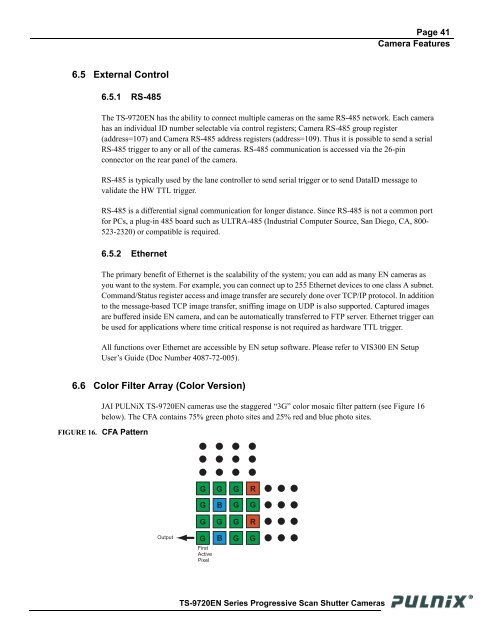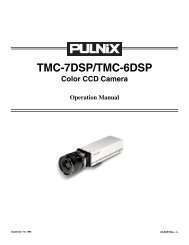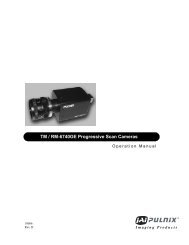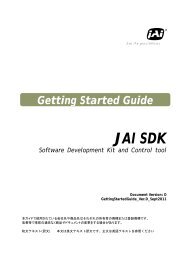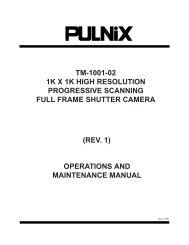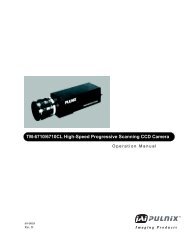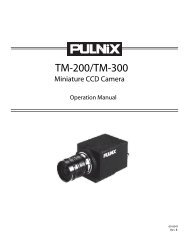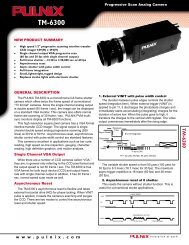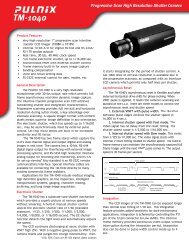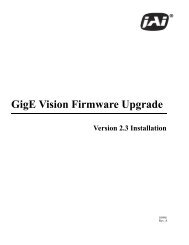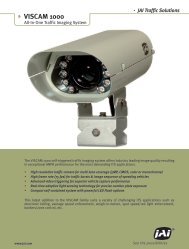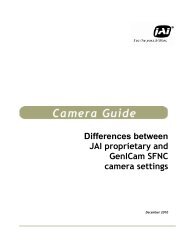TS-9720EN Series Progressive Scan Shutter Cameras - JAI Pulnix
TS-9720EN Series Progressive Scan Shutter Cameras - JAI Pulnix
TS-9720EN Series Progressive Scan Shutter Cameras - JAI Pulnix
You also want an ePaper? Increase the reach of your titles
YUMPU automatically turns print PDFs into web optimized ePapers that Google loves.
Page 41<br />
Camera Features<br />
6.5 External Control<br />
6.5.1 RS-485<br />
The <strong>TS</strong>-<strong>9720EN</strong> has the ability to connect multiple cameras on the same RS-485 network. Each camera<br />
has an individual ID number selectable via control registers; Camera RS-485 group register<br />
(address=107) and Camera RS-485 address registers (address=109). Thus it is possible to send a serial<br />
RS-485 trigger to any or all of the cameras. RS-485 communication is accessed via the 26-pin<br />
connector on the rear panel of the camera.<br />
RS-485 is typically used by the lane controller to send serial trigger or to send DataID message to<br />
validate the HW TTL trigger.<br />
RS-485 is a differential signal communication for longer distance. Since RS-485 is not a common port<br />
for PCs, a plug-in 485 board such as ULTRA-485 (Industrial Computer Source, San Diego, CA, 800-<br />
523-2320) or compatible is required.<br />
6.5.2 Ethernet<br />
The primary benefit of Ethernet is the scalability of the system; you can add as many EN cameras as<br />
you want to the system. For example, you can connect up to 255 Ethernet devices to one class A subnet.<br />
Command/Status register access and image transfer are securely done over TCP/IP protocol. In addition<br />
to the message-based TCP image transfer, sniffing image on UDP is also supported. Captured images<br />
are buffered inside EN camera, and can be automatically transferred to FTP server. Ethernet trigger can<br />
be used for applications where time critical response is not required as hardware TTL trigger.<br />
All functions over Ethernet are accessible by EN setup software. Please refer to VIS300 EN Setup<br />
User’s Guide (Doc Number 4087-72-005).<br />
6.6 Color Filter Array (Color Version)<br />
<strong>JAI</strong> PULNiX <strong>TS</strong>-<strong>9720EN</strong> cameras use the staggered “3G” color mosaic filter pattern (see Figure 16<br />
below). The CFA contains 75% green photo sites and 25% red and blue photo sites.<br />
FIGURE 16. CFA Pattern<br />
G<br />
G<br />
G<br />
R<br />
G<br />
B<br />
G<br />
G<br />
G G G<br />
R<br />
Output<br />
G<br />
First<br />
Active<br />
Pixel<br />
B<br />
G<br />
G<br />
<strong>TS</strong>-<strong>9720EN</strong> <strong>Series</strong> <strong>Progressive</strong> <strong>Scan</strong> <strong>Shutter</strong> <strong>Cameras</strong>


